

Met Gala 2016: Emma Watson wears a Calvin Klein dress made from recycled plastic bottles. H&M on Conscious Materials. New York Designers Share Their Sustainability Goals at the CFDA + Lexus Panel. Yesterday, the CFDA + Lexus Fashion Initiative hosted an afternoon of presentations and open discussions on sustainability and innovation within the fashion industry.

On hand to share their goals (and take questions from a panel of consultants, activists, and eco-minded business owners) were Tome’s Ramon Martin and Ryan Lobo, Dezso’s Sara Beltran, Prabal Gurung, and Brother Vellies’s Aurora James. Stella McCartney Admits That Even She's Not 100% Eco-Friendly. In late April, the Financial Times’s (and soon to be New York Times's) Vanessa Friedman gave a speech at the Copenhagen Fashion Summit on the paradox of sustainability in the fashion industry.
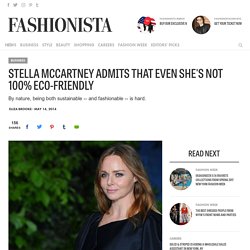
With designers piling on season after sub-season, the imperative to push new styles stands in opposition to any notion of permanence, Friedman argued. There are a few sides to sustainability in fashion. Copenhagen Fashion Week Spotlights Sustainability. Copenhagen Fashion Week, which began Wednesday and runs through Friday, is giving sustainability some good play.
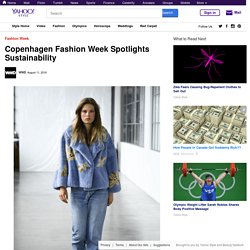
The event held in the wake of the Copenhagen Fashion Summit, which drew 1,250 industry delegates last May, had sustainable label Fonnesbech on its first day — Crown Princess Mary of Denmark sat front row at the Fonnesbech display — and two Swedish brands with a sustainability perspective on day two: House of Dagmar and Uniforms For The Dedicated, two newcomers to the Copenhagen calendar. “The vision is the gap that Copenhagen could fill: to take the position as the sustainability destination and bring together the brands from all over the world who want to work on sustainability,” said Eva Kruse, chief executive officer of Copenhagen Fashion Week, noting that she would like H&M to reveal its Conscious Collection during Copenhagen Fashion Week, as well as draw such players as Stella McCartney and Prada, who both have an ethical point of view in terms of production.
Faux Fur is More Than a Faux Pas, it's Poison. One of the arguments most beloved of the anti-fur lobby is that fake fur is actually better for the environment than the real thing.
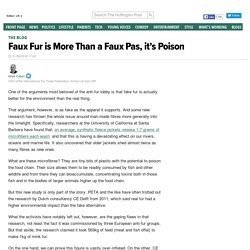
That argument, however, is as fake as the apparel it supports. And some new research has thrown the whole issue around man-made fibres more generally into the limelight. Specifically, researchers at the University of California at Santa Barbara have found that, on average, synthetic fleece jackets release 1.7 grams of microfibers each wash. and that this is having a devastating effect on our rivers, oceans and marine life. It also uncovered that older jackets shed almost twice as many fibres as new ones. What are these microfibres? But this new study is only part of the story. Russian mink farms where thousands are slaughtered and left to rot to make $1m coats. These disturbing pictures expose the macabre truth about the fur farms in Russia and China which supply the fashion market in the world's leading cities, including London, Paris and New York.

Across ten time zones, the images show the reality of mink and sable gulags - many set up during the harsh Communist past - where prized animals are bred for slaughter, bringing in millions of pounds to the Russian economy every single year. An investigation by MailOnline also reveals the appalling conditions in which wild animals, including different types of fox, are captured and killed, from being skinned alive to being poisoned by the faeces in the air, and reveals the heartless farm owners who can't see beyond their profits. And there are certainly profits to be made: a sable 'blanket' sold for a record-breaking $900,000 to a royal just a few years ago, while a coat at last year's Fendi show was rumoured to have a price tag of $1.2million.
Animals forced to suffer and starve in Russian fur farm. Faux Fur is the Only Responsible Choice. A response to Mark Oaten’s article “Faux fur is more than faux pas, it’s poison”.
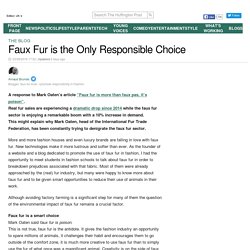
Real fur sales are experiencing a dramatic drop since 2014 while the faux fur sector is enjoying a remarkable boom with a 10% increase in demand. This might explain why Mark Oaten, head of the International Fur Trade Federation, has been constantly trying to denigrate the faux fur sector. More and more fashion houses and even luxury brands are falling in love with faux fur. New technologies make it more lustrous and softer than ever. How PETA Won the Angora Debate and What It Means for Fashion. NEW YORK, United States — In the spring of 2016, a group of top-tier fashion executives convened in midtown Manhattan for a closed-door meeting.
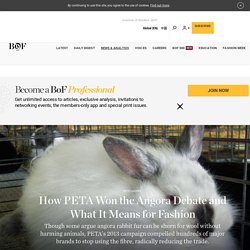
The conversation centred on the treatment of animals and the ethics policies they had in place. It was clear that many brands felt more pressure than ever to cooperate with the People for the Ethical Treatment of Animals — the international non-profit organisation widely known as PETA. “Look at what PETA did to angora,” one executive said. “They virtually wiped it out.”